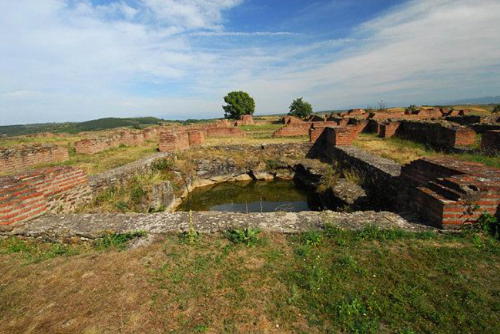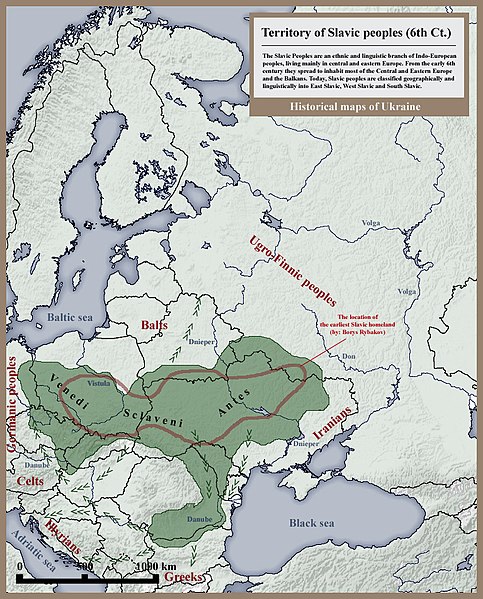Remnants of the city of Justiniana Prima
Defending The Roman Balkans
The City-Fortress of Justiniana Prima
In the centuries after the fall of the Western Roman Empire it is hard to believe that there were any people at all left in Central Asia - - - just about every tribe imaginable marched southwest and invaded the Eastern Roman Empire.
By the year 500AD the entire northern bank of the Danube from Belgrade to the Black Sea was occupied by one Slavic tribe or another. Why these tribes showed up no one knows. But in their desire for loot, slaves or land they put mounting pressure on the Roman frontier. Two of the earliest Slavic tribes were the Antes and the Sclaveni.
By the year 500AD the entire northern bank of the Danube from Belgrade to the Black Sea was occupied by one Slavic tribe or another. Why these tribes showed up no one knows. But in their desire for loot, slaves or land they put mounting pressure on the Roman frontier. Two of the earliest Slavic tribes were the Antes and the Sclaveni.
Justiniana Prima was one of the many fortified cities founded by the Emperor Justinian to help stabilize the Balkan frontier. The city existed from 535 to 615 near modern Lebane in southern Serbia. The city served as the metropolitan seat of the Archbishopric of Justiniana Prima, that had jurisdiction over the provinces of the Diocese of Dacia.
The city was a completely new foundation in honour of the nearby village of Tauresium, the birthplace of Justinian. According to Procopius Bederiana, the birthplace of Justinian's uncle and mentor Justin I was nearby.
Justinian himself ordered the foundation of the city by law in 535, establishing the Archbishopric of Justiniana Prima, making it at the same time the capital of the prefecture of Illyricum instead of Thessaloniki (although this is disputed among historians).
Justinian made sure that this city, which was one of his favorite projects, received all the necessary support.
- "He therefore built a wall of small compass about this place in the form of a square, placing a tower at each corner, and caused it to be called, as it actually is, Tetrapyrgia. And close by this place he built a very notable city which he named Justiniana Prima, thus paying a debt of gratitude to the home that fostered him. In that place also he constructed an aqueduct and so caused the city to be abundantly supplied with ever-running water. And many other enterprises were carried out by the founder of this city - works of great size and worthy of especial note. For to enumerate the churches is not easy, and it is impossible to tell in words of the lodgings for magistrates, the great stoas, the fine marketplaces, the fountains, the streets, the baths, the shops. In brief, the city is both great and populous and blessed in every way."
- Procopius' description of Justiniana Prima in The Buildings.
The town was abandoned at around 615. Invading Avars coming from north of the Danube may be one factor, missing political interest in the town after the time of Justinian may be another.
Recreation of Justiniana Prima
Contemporary Historian Procopius:
Thus did the Emperor Justinian fortify the whole interior of Illyricum. I shall also explain in what manner he fortified the bank of the Ister River, which they also call the Danube, by means of strongholds and garrisons of troops.
The Roman Emperors of former times, by way of preventing the crossing of the Danube by the barbarians who live on the other side, occupied the entire bank of this river with strongholds, and not the right bank of the stream alone, for in some parts of it they built towns and fortresses on its other bank. However, they did not so build these strongholds that they were impossible to attack, if anyone should come against them, but they only provided that the bank of the river was not left destitute of men, since the barbarians there had no knowledge of storming walls.
In fact the majority of these strongholds consisted only of a single tower, and they were called appropriately "lone towers," and very few men were stationed in them. At that time this alone was quite sufficient to frighten off the barbarian clans, so that they would not undertake to attack the Romans. But at a later time Attila invaded with a great army, and with no difficulty razed the fortresses; then, with no one standing against him, he plundered the greater part of the Roman Empire.
But the Emperor Justinian rebuilt the defences which had been torn down, not simply as they had been before, but so as to give the fortifications the greatest possible strength; and he added many more which he built himself. In this way he completely restored the safety of the Roman Empire, which by then had been lost.
A recreation of a "single tower" Roman fortification.
Justiniana Prima in 1937. Photo archive of the
Military Geographical Institute of Serbia.
Justiniana Prima
Endless Slavic tribes pounded the Roman
fortifications in the Balkans.
The Collapse of the Roman Empire
.
By 650 AD (map above) the Balkan Roman frontier was in complete collapse with Slavic tribes advancing all the way to southern Greece.
The first appearance of the Slavs in the Eastern Roman Empire can be dated no earlier than the 6th century. Throughout this century, beginning with the reign of Justinian, Slavs repeatedly invaded the Balkan possessions of the Empire. Not until the reign of Maurice, however, did any Slavs settle in these territories. Between the years 579-587 there took place the irruption of several barbarian waves led by the Avars, but consisting mostly of Slavs. The latter came in great numbers, and, as the troops of the Empire were engaged in the war with Persia, they roamed the country at will.
Slavs devastated Illyricum and Thrace, penetrated deep into Greece and the Peloponnesus, helped the Avars to take numerous cities, including Singidunum, Viminacium (Kostolac), Durostorum (Silistria), Marcianopolis, Anchialus, and Corinth, and in 586 laid siege to the city of Thessalonica, the first of a series of great sieges which that city was destined to undergo at their hands. What is more, they came to stay.
(Procopius Buildings) (unesco) (Justiniana)
(panacomp.net) (justiniana-prima.blogspot.com)










No comments:
Post a Comment